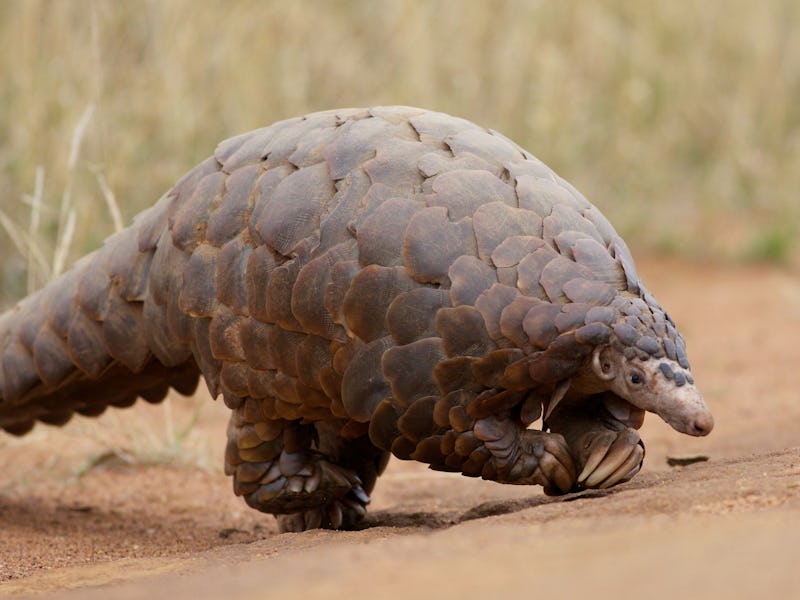5 Facts About Pangolins That Prove They Are the Coolest
You have more in common with this scaly mammal than you think.

This is a pangolin. It is adorable, and unfortunately, severely threatened: The little guy is coveted for his meat and scales, which are used in Chinese medicine. Just last month, four tons of poached pangolin scales were discovered by officials in Hong Kong. That’s a big blow for the pangolins, considered one of the most heavily poached mammals on Earth.
Yes, I said “mammal.” This little critter might look ancient, but he’s actually more closely related to Lil Bub, the internet-famous cat, than to scaly lizards, or even to the similar-looking armadillos and anteaters. The strange thing about evolution is that displaying similar characteristics does not indicate a genetic relationship, and your instincts will often steer you off course. No animal teaches this lesson as well (or as adorably) as the pangolin.
Pangolins are covered in scales
Pangolin scales are made of keratin, which is the same stuff your hair, fingernails, and toenails are made of. Keratin, a fibrous structural protein, is a building block for nearly all of the hard and soft coverings in mammals, reptiles, dinosaurs, and birds, including scales, feathers, beaks, and claws. How a particular animal uses keratin to cover itself depends on what worked best (evolutionarily speaking) for its ancestors. It’s not that the pangolin never lost the traits of a reptilian ancestor; rather, it’s that the pangolin had furry ancestors, but over time, that fur turned out to be more useful in defense than in heat regulation. This, if you look around you, is not so strange after all — the porcupine learned the same thing through its own series of genetic accidents.
Pangolins give birth to live young
A great distinguishing feature of mammals is that females have mammary glands that produce milk to feed the young. When it comes to giving birth, however, not all mammals are the same. There are the monotremes, egg-laying mammals like the platypus and the echidna, which branched off from the mammal family tree back when egg-laying was the norm, and never lost that trait. The pangolin may look much like an echidna, but they are not closely related. Their similar traits are a matter of convergent evolution, which explains how unrelated animals develop similar characteristics as they adapt to similar environments. Pangolins are more like humans and most mammals in this respect and can be grouped with the most common placental mammals, giving birth to a relatively developed young.
Pangolins have no teeth
Pangolins are sometimes called scaly anteaters, although they are not closely related to the true anteaters. Strangely, the closest living relatives of the pangolin belong to the order Carnivora, which include cats, dogs, bears, and even walruses and seals. But unlike their meat-eating kin, pangolins have no teeth. They are adapted for eating insects, snuffling around and lapping up ants and termites with their long tongues. Again, this is a matter of convergent evolution. Pangolin ancestors may have had sharp teeth but, finding insects to be delicious and plentiful, they evolved towards efficient bug hunting over many generations.
Pangolins have teeny tiny eyes
We like to think of evolution as a progression, marching towards increasing levels of complexity. But spending energy on organs that don’t help you all that much is a waste, and it can actually be beneficial to head in the opposite direction. Pangolins are not blind, but their eyesight is poor. What good are eyes when a nose is better at finding ant hills? What’s the use of eyes to spot predators, when you are covered in an armor of scales and are better off balling up than running away? There is no use, the pangolins say.
Pangolins emit a skunky odor in defense
Pangolins have a gland near their anus that emits a nasty odor. They cannot spray like a skunk, but it’s still gross enough to make some predators think twice about taking a bite. Pangolins are very skunk-like, if you look at their body shape and how they move around. And it’s yet another example of convergent evolution. Although skunks and pangolins are much more closely related than anteaters and pangolins, it is very likely that they developed their stank separately. Other carnivores have anal glands that are sometimes stinky, but they don’t use it to fend off predators. Makes farts seem quaint.